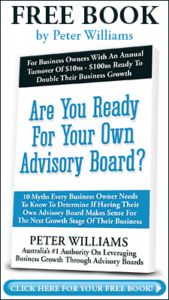
Originally Published: Smart Company, October 2, 2018
Boards and their directors have been under the microscope in the past few months as the financial services royal commission uncovers some alarming practices from within some of Australia’s largest and most iconic financial institutions.
Under Australia’s current single-tier board system, the traditional board of directors has oversight for a whole organisation’s governance. In the case of a massive organisation such as Commonwealth Bank, this means the ten part-time directors oversee a business with assets of almost a trillion dollars, with more than 40,000 staff. With organisations this large, you would have to question how any board could have an accurate line of sight to what is actually going on.
Countries such as Germany have a two-tier system, with the traditional board of directors supported by an advisory or strategy board. Some of the world’s largest banks do just this. Why couldn’t Australian banks set up advisory boards for each business division and also for each state, which would give them the line of sight needed for good oversight?
Part of the reason we don’t see many advisory boards is that they are a fairly new concept in Australia. Advisory boards are best suited for private and family businesses with a turnover of between $5 million and $100 million, although there is no real upper limit. They are also good for ASX-listed companies as a source of guidance for the chief executive to road test their ideas or gain fresh perspectives and challenges before they are forced to be more definitive and assertive before a board of directors.
And they’re an untapped opportunity to grow a business as they are more adaptable, flexible, strategic and affordable than the more traditional board of directors.
Advisory boards have been utilised a bit longer in Canada, and there’s been some research on how businesses that have them compare to those who don’t. Research carried out by the Business Development Bank of Canada (BDC) in 2014 surveyed almost 4,000 business owners across the country, as well as reviewing the economic literature and talking to a range of business experts.
The survey looked at what percentage of businesses had an advisory board, how it operated if they did, and how the company was performing. The BDC’s findings are eye-opening: sales grew by 66.8% on average in the first three years after setting up an advisory board. Productivity in the same period rose by 5.9%, against a 3.2% rise in the previous three years. On average, annual sales for businesses with an advisory board were 24% higher than those without one, and productivity was 18% higher.
Many business owners and chief executive officers have an informal network that provides a sounding board. Very few have formalised this access to include high quality and successful advisers by creating a business advisory board. But for those who do, there is significant evidence an advisory board will dramatically improve performance.
There are two ways to set up an advisory board: do it yourself or rent a ready-made, high-impact board.
Doing it yourself
- Set your objectives;
- Assess and document your current skills and competencies;
- Identify the gaps in skills and competencies;
- Advertise, select and recruit advisers;
- Develop your own board support tools including board documents, policies and processes; and
- Establish and manage the board process.
Renting a ready-made board of proven board advisers and chairperson
- Review with the chairman to identify the holes and goals of the business and the objectives;
- Handpick the required skill sets from an accredited panel of advisers which are ahead of you and have already achieved what you are trying to achieve;
- Utilise the proven board support tools establish the board within one-two weeks;
- Evolve and evaluate the board; and
- Measure and evaluate the impact and profitability of the board.
An advisory board structure is one of the best ways to get ongoing access to the expertise you need. It’s also a good way to get around a very real problem that most business owners discover when they get to a certain level — it’s lonely at the top.

